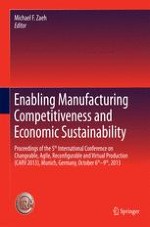The changing manufacturing environment requires more responsive and adaptable manufacturing systems. The theme of the 5th International Conference on Changeable, Agile, Reconfigurable and Virtual production (CARV2013) is "Enabling Manufacturing Competitiveness and Economic Sustainability. Leading edge research and best implementation practices and experiences, which address these important issues and challenges, are presented. The proceedings include advances in manufacturing systems design, planning, evaluation, control and evolving paradigms such as mass customization, personalization, changeability, re-configurability and flexibility. New and important concepts such as the dynamic product families and platforms, co-evolution of products and systems, and methods for enhancing manufacturing systems' economic sustainability and prolonging their life to produce more than one product generation are treated. Enablers of change in manufacturing systems, production volume and capability, scalability and managing the volatility of markets, competition among global enterprises and the increasing complexity of products, manufacturing systems and management strategies are discussed. Industry challenges and future directions for research and development needed to help both practitioners and academicians are presented.
About the Editor
Prof. Dr.-Ing. Michael F. Zaeh, born in 1963, has been and is Professor for and Manufacturing Technology since 2002 and, together with Prof. Dr.-Ing. Gunther Reinhart, Head of the Institute for Machine Tools and Industrial Management (iwb) at the Technische Universitaet Muenchen (TUM). After studying general mechanical engineering, he was doctoral candidate under Prof. Dr.-Ing. Joachim Milberg at TUM from 1990 until 1993 and received his doctorate in 1993. From 1994 to 1995, he was department leader under Prof. Dr.-Ing. Gunther Reinhart. From 1996 to 2002, he worked for a machine tool manufacturer in several positions, most recently as a member of the extended management.
Prof. Dr.-Ing. Michael F. Zaeh is an associated member of the CIRP and member of acatech, WGP and WLP. His current researches include among others Joining and Cutting Technologies like Laser Cutting and Welding as well as Friction Stir Welding, Structural Behaviour and Energy Efficiency of Machine Tools and Manufacturing Processes like Additive Manufacturing.
